Australian Athletes Alliance - Attorney-General's Department
Australian Athletes Alliance - Attorney-General's Department
Australian Athletes Alliance - Attorney-General's Department
Create successful ePaper yourself
Turn your PDF publications into a flip-book with our unique Google optimized e-Paper software.
DEPARTMENT OF PRIME MINISTER AND CABINET<br />
ISSUES PAPER, SEPTEMBER 2011<br />
A COMMONWEALTH STATUTORY CAUSE OF ACTION FOR SERIOUS<br />
INVASION OF PRIVACY<br />
Submission of <strong>Australian</strong> <strong>Athletes</strong>’ <strong>Alliance</strong> Inc.<br />
The <strong>Australian</strong> <strong>Athletes</strong>’ <strong>Alliance</strong> Inc (AAA) is the peak body of associations representing<br />
<strong>Australian</strong> athletes.<br />
The current members of the AAA are the:<br />
• <strong>Australian</strong> Cricketers’ Association;<br />
• AFL Players’ Association;<br />
• <strong>Australian</strong> Jockeys’ Association;<br />
• <strong>Australian</strong> Netballers’ Association;<br />
• <strong>Australian</strong> Swimmers’ Association;<br />
• Professional Footballers Association;<br />
• Rugby League Players’ Association; and<br />
• Rugby Union Players’ Association.<br />
Our member associations represent over 3,000 of Australia’s elite professional<br />
sportspeople.<br />
As the peak body, we provide a unified voice on issues affecting <strong>Australian</strong> athletes.<br />
The <strong>Department</strong> of Prime Minister and Cabinet Issues Paper, A Commonwealth<br />
Statutory Cause of Action for Serious Invasion of Privacy, invited comments on<br />
whether Australia should introduce a statutory cause of action for privacy and, if so,<br />
what elements the statutory cause of action might include. The Paper invited<br />
responses to specific questions which it set out, as well as more general comments.<br />
In this submission, we have first answered the general question of whether such a<br />
statutory cause of action should be introduced, then set out our proposed elements<br />
of such a cause of action and, finally, have responded to each of the 19 questions<br />
set out in the Issues Paper.<br />
<strong>Australian</strong> <strong>Athletes</strong>’ <strong>Alliance</strong> Inc.<br />
ABN: 70 330 435 459<br />
833 Bourke Street, Docklands VIC AUS 3008<br />
P: +61 3 9287 1888 F: +61 3 9287 1760 www.athletesalliance.org.au
Page 2<br />
SHOULD A STATUTORY CAUSE OF ACTION BE INTRODUCED?<br />
Before providing our specific proposal below, we note that our primary interest is in<br />
protecting the privacy of athletes, whose private lives are increasingly under<br />
inappropriate public scrutiny.<br />
We acknowledge that many professional athletes benefit financially from their public<br />
profile. We believe, however, that professional athletes and other individuals with a<br />
public profile should still be entitled to lead their private lives with dignity, free from<br />
unreasonable interference into their personal space and from the substantial distress<br />
which may be caused by the dissemination of private information or other material.<br />
Recent developments in technology make this an issue of growing concern.<br />
We are in favour of a right of action that codifies the distinction between matters of<br />
legitimate public interest and matters of mere public curiosity. Such a right of action<br />
would not interfere with the public’s interest in the athlete as a practitioner of his or<br />
her sport, but would protect the privacy of the athlete in his or her private life,<br />
outside the practice of sport. Moreover, we favour a cause of action that will provide<br />
a clear disincentive for any breach of suitable privacy standards by allowing a suit<br />
for damages.<br />
PROPOSED ELEMENTS OF A STATUTORY CAUSE OF ACTION<br />
The AAA is broadly supportive of the approach taken by the <strong>Australian</strong> Law Reform<br />
Commission (ALRC), 1 but with some adjustments.<br />
Under the ALRC approach, a cause of action could not be made out if an invasion of<br />
privacy was significant but did not meet the high standard of being “highly<br />
offensive”.<br />
We believe that this sets the bar too high and prefer the approach set out in the<br />
ALRC’s earlier Discussion Paper. 2<br />
Based on the approach taken in the ALRC’s earlier Discussion Paper, we propose<br />
that the primary elements of the cause of action would be made out if a plaintiff<br />
could show that:<br />
1 <strong>Australian</strong> Law Reform Commission, Report 108 – For Your Information: <strong>Australian</strong> Privacy Law and<br />
Practice (2008).<br />
2 <strong>Australian</strong> Law Reform Commission, Discussion Paper 72 – Review of <strong>Australian</strong> Privacy Law<br />
(2007), [5.78] to [5.80] and [5.119].
Page 3<br />
(a) there has been an invasion of the privacy of the plaintiff;<br />
(b) in circumstances where the plaintiff was reasonably entitled to expect his or her<br />
privacy to be respected; and<br />
(c) the interference complained of is sufficiently serious to be likely to cause<br />
substantial distress or concern to a person of ordinary sensibilities.<br />
We believe that a non-exhaustive list of what may constitute an invasion of privacy,<br />
similar to that included in the ALRC Report and Discussion Paper should be included<br />
in any legislation.<br />
We also support the inclusion of defences similar to those proposed in the ALRC final<br />
Report and Discussion Paper and would include public interest considerations among<br />
the available defences, rather than as an element of the cause of action.<br />
RESPONSES TO QUESTIONS POSED IN ISSUES PAPER<br />
The following is the AAA’s response to each of the questions posed in the Issues<br />
Paper.<br />
1. Do recent developments in technology mean that additional ways of<br />
protecting individuals’ privacy should be considered in Australia?<br />
While we believe that an individual should be entitled to redress for an inappropriate<br />
interference with his or her privacy regardless of the technology used, there is no<br />
doubt that recent technological developments have increased the need for the law to<br />
respond in this area.<br />
2. Is there a need for a cause of action for serious breach of privacy in<br />
Australia?<br />
Australia is one of the only developed countries that does not recognise privacy as a<br />
basic civil or human right. In 1948, Australia voted in favour of the United Nations<br />
Declaration of Human Rights (UNDHR). It is time for our nation to implement article<br />
12 of the UNDHR which states that “No one shall be subjected to arbitrary<br />
interference with his privacy, family, home or correspondence... Everyone has the<br />
right to the protection of the law against such interference or attacks.”<br />
There is a need for a statutory cause of action to act as a disincentive to interfere<br />
with individuals’ reasonable expectations of privacy and to provide a means of<br />
redress where those expectations are infringed in a significant way.
Page 4<br />
We note that self-regulation has not worked.<br />
The Press Council’s, Privacy Principle 1 states that “journalists should seek personal<br />
information only in the public interest. In doing so, journalists should not unduly<br />
intrude on the privacy of individuals and should show respect for the dignity and<br />
sensitivity of people encountered in the course of gathering news” and that “public<br />
figures do not forfeit their right to privacy altogether. Intrusion into their right to<br />
privacy must be related to their public duties or activities.”<br />
In our experience, the <strong>Australian</strong> media has not met this standard.<br />
For example, in the sport of <strong>Australian</strong> rules football alone, examples of<br />
inappropriate conduct by media outlets in recent years include a television network<br />
broadcasting contents of stolen medical records and newspapers publishing<br />
photographs of a player while an in-patient at a medical treatment facility.<br />
3. Should any cause of action for serious invasion of privacy be created<br />
by statute or be left to develop at common law?<br />
The cause of action should be created by statute.<br />
First, the protection is needed now. Creation through common law is a slow process<br />
given the adherence to precedent and the judicial restraint normally exhibited by<br />
courts. For instance, it was twenty-one years from the denial of native title in<br />
Milirrpum v Nabalco Pty Ltd (1971) 17 FLR 141 to the recognition of right of native<br />
title in Mabo v State of Queensland [1992] HCA 23.<br />
Second, it is important that the law regarding privacy be certain and consistent. A<br />
statute would provide certainty immediately, while allowing the right to develop<br />
through case law is a slower process that would likely lead to inconsistent results<br />
until a case is finally decided by the High Court.<br />
Third, it is unreasonable to require parties to incur the costs and time required in<br />
litigation to have this right recognised when their elected representatives can act on<br />
the issue.<br />
Finally, the courts typically look to Parliament to act as primary law maker and<br />
unless Parliament acts to establish a cause of action, there is no guarantee that it<br />
would ever occur.
Page 5<br />
4. Is ‘highly offensive’ an appropriate standard for a cause of action<br />
relating to serious invasions of privacy?<br />
As noted earlier, we believe that the standard recommended in the ALRC’s final<br />
Report sets the bar too high.<br />
We believe that the test should be worded as follows (similar to what was proposed<br />
in the ALRC’s earlier Discussion Paper):<br />
that the interference complained of is sufficiently serious to be likely to cause<br />
substantial distress or concern to a person of ordinary sensibilities.<br />
The purpose of the inclusion of such an element in the cause of action would be to<br />
exclude trivial cases.<br />
By including an objective test of “substantiality”, we believe that objective would be<br />
achieved.<br />
On the other hand, we believe that raising the bar further to require that the<br />
relevant conduct be “highly offensive” to an ordinary person would be unfairly<br />
excluding a remedy in a number of substantial cases.<br />
We also prefer the term “distress or concern” to “offensive”, as we consider this<br />
more clearly captures the relevant standard as to the impact the relevant conduct is<br />
required to have upon an ordinary person in order to constitute a cause of action.<br />
“Offensive” on one view may be understood as meaning “insulting” rather than<br />
“distressing”, “concerning” or “upsetting”.<br />
5. Should the balancing of interests in any proposed cause of action be<br />
integrated into the cause of action (ALRC, NSWLRC) or constitute a<br />
separate defence (VLRC)?<br />
The balancing of interests should be a separate defence. The plaintiff should first<br />
establish that there was an invasion of privacy. The defendant could then argue that<br />
the public interest in the information obtained and/or in the breach itself outweighed<br />
the plaintiff’s privacy interest. Consent would also be a defence. We agree with the<br />
VLRC that a plaintiff should not be required to prove a negative, such as the absence<br />
of a countervailing interest.
Page 6<br />
6. How best could a statutory cause of action recognise the public<br />
interest in freedom of expression?<br />
The public interest in freedom of expression should be protected in two ways.<br />
The first is by appropriately confining the elements of the cause of action.<br />
Our earlier proposal was to confine the cause of action to circumstances where there<br />
has not just been an infringement of privacy, but the person infringed also had a<br />
reasonable expectation of privacy and the infringement would be likely to have a<br />
substantial impact.<br />
The second is by the inclusion of a public interest defence, so that even if these<br />
elements are made out (and therefore a substantial invasion of privacy is<br />
established), this will not constitute an enforceable cause of action if it is justified in<br />
the public interest.<br />
7. Is the inclusion of “intentional” or “reckless” as fault elements for any<br />
proposed cause of action appropriate, or should it contain different<br />
requirements as to fault?<br />
In addition to intentional and reckless, there should be a fault element where the<br />
violation of someone’s privacy is the result of a breach of a legal obligation of<br />
confidence.<br />
For instance, a medical practice has the legal obligation to protect the medical<br />
information of patients. If they breach that obligation in any way, they should be<br />
jointly and severably liable for any breach of privacy that results. As an example, if a<br />
medical clinic’s failure to protect its patient records allowed inappropriate access to a<br />
person and that person subsequently broadcasts the information in those patient<br />
records, the clinic would liable for the breach of the patient’s privacy even if the<br />
clinic did not, itself, broadcast the information.<br />
8. Should any legislation allow for the consideration of other relevant<br />
matters, and, if so, is the list of matters proposed by the NSWLRC<br />
necessary and sufficient?<br />
As proposed above, we believe that the circumstances of the interference with<br />
privacy and the likely effect on an ordinary person should be taken into account as<br />
part of the cause of action.
Page 7<br />
The only other relevant consideration should be an overriding compelling public<br />
interest, which should be incorporated into any legislation as a defence.<br />
9. Should a non-exhaustive list of activities which could constitute an<br />
invasion of privacy be included in the legislation creating a statutory<br />
cause of action, or in other explanatory material? If a list were to be<br />
included, should any changes be made to the list proposed by the<br />
ALRC?<br />
We believe that the non-exhaustive list set out by the ALRC is sufficient with one<br />
minor change: we would modify the first example as follows to include a person’s<br />
personal life, consistent with article 12 of the UNDHR:<br />
a) there has been an interference with an individual’s, home, personal, or<br />
family life.<br />
10. What should be included as defences to any proposed cause of action?<br />
Defences should be: 1) consent; and 2) that there was a compelling public interest<br />
that outweighed the individual’s right of privacy.<br />
Compelling interests would include that the invasion of privacy was:<br />
• incidental to the exercise of a lawful right to defend person or property;<br />
• required or authorised by law;<br />
• required for law enforcement; or<br />
• for the purpose of informing the public on a matter within the public’s legitimate<br />
interest.<br />
11. Should particular organisations or types of organisations be excluded<br />
from the ambit of any proposed cause of action, or should defences be<br />
used to restrict its application?<br />
We agree with the VLRC conclusion that “no organisations or classes of people be<br />
exempted from the proposed statutory causes of action. The defences adequately<br />
protect people engaged in legitimate activities from unmeritorious actions for serious<br />
invasions of privacy”. 3<br />
12. Are the remedies recommended by the ALRC necessary and sufficient<br />
for, and appropriate to, the proposed cause of action?<br />
3 Victorian Law Reform Commission, Surveillance in Public Places: Final Report 18 (2010), [7.194].
Page 8<br />
We believe that the remedies recommended by the ALRC are generally appropriate<br />
and should be adopted with one modification: the court should be permitted to<br />
assess exemplary damages where appropriate.<br />
13. Should the legislation prescribe a maximum award of damages for<br />
non-economic loss, and if so, what should that limit be?<br />
We agree with the VLRC and ALRC that there should not be a statutory cap for noneconomic<br />
loss.<br />
14. Should any proposed cause of action require proof of damage? If so,<br />
how should damage be defined for the purposes of the cause of<br />
action?<br />
We agree with the ALRC recommendation that claims under the proposed cause of<br />
action be actionable without proof of damage.<br />
15. Should any proposed cause of action also allow for an offer of amends<br />
process?<br />
We would not be opposed to an offer of amends process so long as it did not afford<br />
the defendant a defence to the action.<br />
16. Should any proposed cause of action be restricted to natural persons?<br />
We agree with the ALRC, NSWLRC 4 and VLRC. The right of privacy is a human right,<br />
thus should apply only to natural persons.<br />
17. Should any proposed cause of action be restricted to living persons?<br />
We agree with the ALRC, NSWLRC and VLRC that the action should be restricted to<br />
living persons.<br />
18. Within what period, and from what date, should an action for serious<br />
invasion of privacy be required to be commenced?<br />
We agree with the VLRC that a three-year limitation period is appropriate as it<br />
accords with the limitation period for personal injury actions as well as the outer<br />
limit for defamation actions. While defamation requires publication and is thus more<br />
4 New South Wales Law Reform Commission, Report 120: Invasion of Privacy (2009).
Page 9<br />
immediately apparent, privacy may be breached without a public act and thus may<br />
take longer to uncover.<br />
19. Which forums should have jurisdiction to hear and determine claims<br />
made for serious invasion of privacy?<br />
Plaintiffs should have access to both Federal and state courts for claims regarding<br />
the invasion of their privacy.<br />
CONCLUSION<br />
We thank the <strong>Department</strong> for the opportunity to provide these comments.<br />
We would be pleased to provide any further assistance which the <strong>Department</strong> requires.<br />
For any further information or assistance, please contact:<br />
Brendan Schwab<br />
General Secretary<br />
<strong>Australian</strong> <strong>Athletes</strong>’ <strong>Alliance</strong> Inc.<br />
c/- Professional Footballers Australia<br />
833 Bourke Street<br />
DOCKLANDS VIC 3088<br />
Ph: (03) 9287 1888<br />
Fax: (03) 9287 1760<br />
Email: brendan@pfa.net.au


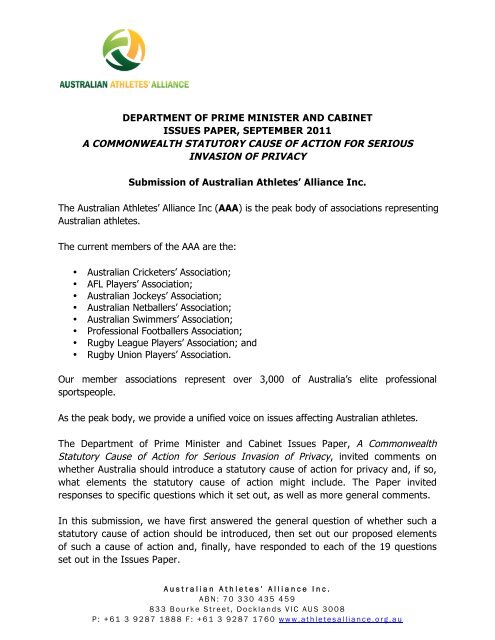
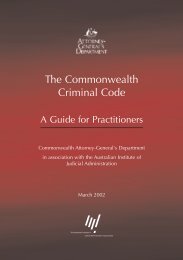
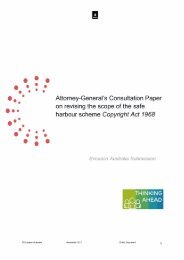

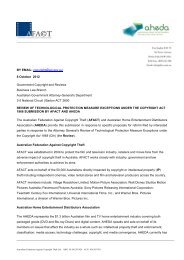

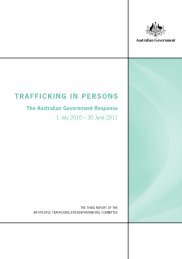

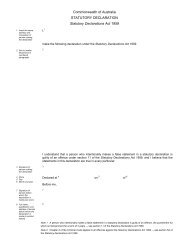

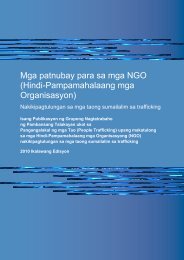
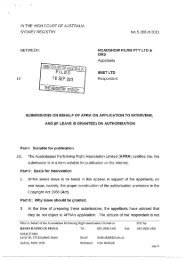
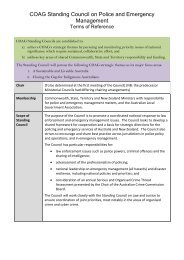

![Normann Witzleb [PDF 657KB] - Attorney-General's Department](https://img.yumpu.com/26247895/1/184x260/normann-witzleb-pdf-657kb-attorney-generals-department.jpg?quality=85)